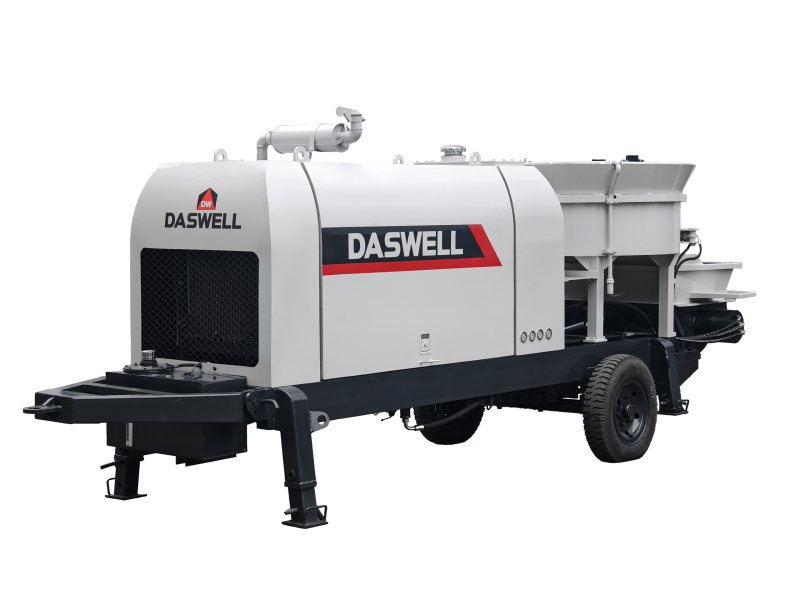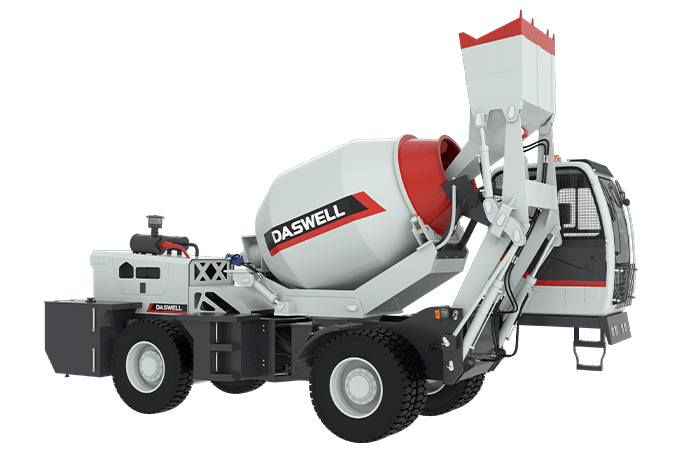-
Trailer Line Pump
What Is a Trailer Line Pump?
A trailer line pump—also known as a concrete trailer pump or transfer pump—is a towable, skid-mounted concrete pumping unit that transfers concrete from the mixer to the point of placement via flexible pipelines. Ideal for medium-distance, multi-level, or space-restricted projects where boom arms are not necessary.
Key Features & Specifications
- Output Capacity: 30–90 m³/h with maximum pressure between 10–22 MPa.
- Valve System: S-valve design suitable for aggregates up to 40 mm.
- Diesel/Electric Versions: Choose electric for urban, emission-sensitive environments, or diesel for remote sites.
- Variable Model Sizes: Ranging from compact 30 m³/h units to heavy-duty 90 m³/h pumps, plus special models for tunnels and bridges.

How It Works
- Setup: Tow behind mixer truck, deploy outriggers and lay pipeline.
- Feeding: Concrete discharged into hopper.
- Pumping: Hydraulic pistons drive concrete through hoses to the discharge end.
- Clean-up: Pipes disassembled and cleaned after use.
Advantages of Trailer Line Pumps
- High efficiency: Delivers similar output to boom pumps without the complexity.
- Cost-effective: More affordable and easier to maintain than boom systems.
- Versatile reach: Capable of pumping up to ~2000 m horizontally and 400 m vertically.
- Compact & flexible: Easily navigates tight urban environments.
Recommended Use Cases
- Residential slabs, sidewalks, and pool construction
- Commercial floor placements and warehouse setups
- Infrastructure works: bridges, tunnels, culverts, and canal linings
Why Choose Daswell Trailer Line Pumps
Daswell’s trailer line pumps feature high-quality diesel or electric power, robust S-valve systems, and brand-name components like Rexroth, Kawasaki, Atos, and Weichai. With models delivering 30–90 m³/h and equipped for aggregates up to 40 mm, they provide reliable performance for a range of project types.
About Daswell Machinery
With over 20 years in the construction equipment sector, Daswell Machinery specializes in comprehensive concrete solutions. Our lineup includes Concrete Mixer Pumps, Trailer Line Pumps, and Boom Concrete Pumps.
We also provide supporting machinery such as Self‐Loading Mixers, Batching Plants, Mobile Crushers, Grinding Mills, Drilling Rigs, cranes, and more.
We deliver tailored equipment, fast global shipping, local service teams, and full technical support—helping your projects stay efficient and cost-effective.
Visit our official website: https://www.daswell.com
Contact us today for a free quote or expert consultation!PR -
What is a Self-Loading Concrete Mixer?
What is a Self-Loading Concrete Mixer?
In today’s fast-paced construction environment, contractors are constantly seeking ways to reduce costs, increase productivity, and maintain high-quality results. One piece of equipment that has transformed small to medium-scale concrete projects is the self loading concrete mixer. But what exactly is it, and why is it gaining popularity across the globe?
A Smart All-in-One Concrete Solution
A self-loading concrete mixer is an integrated machine that combines the functions of a concrete mixer, loader, and transporter into a single unit. Unlike traditional concrete batching and mixing setups, which require multiple machines and personnel, a self-loading mixer streamlines the entire process.
With just one operator, the machine can:
-
Load materials (cement, aggregates, sand) automatically using its front bucket
-
Weigh and measure mix proportions accurately
-
Mix the concrete while in transit
-
Transport and discharge the finished concrete directly at the job site
This level of autonomy makes it ideal for remote sites, tight urban areas, and projects where time and efficiency are crucial.
Key Benefits of Using a Self-Loading Mixer
1. Labor and Equipment Savings
Instead of requiring a loader, batching plant, and transit mixer, one self-loading mixer handles it all—significantly reducing labor and fuel costs.
2. Mobility and Independence
Thanks to its 4WD capability and off-road tires, the machine can operate in rough terrains without the need for paved roads or external infrastructure.
3. Precise Mixing
Modern models come equipped with electronic weighing systems and water flow meters to ensure consistent and high-quality concrete output.
4. Fast ROI
Contractors find the return on investment attractive due to reduced overhead, minimized downtime, and faster project completion times.
Who Should Use a Self-Loading Concrete Mixer?
Self-loading mixers are particularly suitable for:
-
Small to medium-scale residential or commercial construction
-
Road and bridge maintenance projects
-
Remote or mountainous regions with limited access to batching plants
-
Contractors looking for maximum versatility with minimal operational complexity
Why It’s Worth the Investment
Whether you're building rural infrastructure, casting foundations, or running a mobile project team, a self-loading concrete mixer can dramatically improve efficiency. It simplifies the logistics of concrete production, allows real-time mix adjustments, and increases job site autonomy.

About Daswell Machinery
With over 20 years of experience in the construction and mining equipment industry, Daswell Machinery is committed to delivering high-quality, efficient, and reliable machinery for global clients. Our product range includes self-loading mixers, concrete batching plants, concrete pumps, crushers, wheel loaders, and more — all engineered to meet the demands of real job sites.
We support our customers not just with robust equipment, but with complete solutions, including customized configurations, local service teams, technical support, and fast delivery in key markets around the world.
Whether you're starting a new project or upgrading your equipment, Daswell is here to help you build smarter and work more efficiently.
Visit our official website: https://www.daswell.com
Contact us for a free quote or consultation today! -
-
無題
By CNC milling in the back plate to form a custom flow channel, the flow channel is arranged with fins, using friction stir welding welded seal, especially suitable for high pressure conditions, high power density environment. The welding strength of the friction stir welding water cooled plate is equivalent to more than 90% of the base material, and the pressure is 10bar~30bar, or even higher.
-
Metal Casting Process - Die casting
Die casting is a metal casting process characterized by the use of a mold cavity to apply high pressure to melted metal. Molds are usually machined with higher strength alloys, in a process somewhat similar to injection molding. Most die casting castings are iron-free, such as zinc, copper, aluminum, magnesium, lead, tin, and lead-tin alloys and their alloys. Depending on the type of die casting, either a cold chamber die casting machine or a hot chamber die casting machine is required.
The cost of casting equipment and molds is high, so the die casting process is generally only used to mass-produce a large number of products. It is relatively easy to manufacture die-cast parts, which generally requires only four major steps and a low individual cost increment. Die casting is particularly suitable for manufacturing a large number of small and medium-sized castings, so die casting is one of the most widely used in various casting processes. Compared to other casting technologies, die casting has a flatter surface and a higher dimensional consistency.
On the basis of the traditional die casting process, several improved processes have been born, including the non-porous die casting process to reduce the casting defect exclusion porosity. Mainly used for processing zinc, which can reduce waste and increase the yield of direct injection process. There are also new die-casting processes such as precision and close die-casting technology and semi-solid die-casting invented by Lori.
-
無題
CNC machining is a manufacturing technology that uses computer-controlled machine tools to cut, punch, drill, mill, turn, grind, etc., for the manufacture of various parts and components. CNC stands for computer numerical control, which is an automatic processing method that can accurately control the processing process through digital control instructions, so as to achieve high-precision and high-efficiency processing.
CNC machining has a wide range of applications. From aircraft parts, auto parts, ship parts, artificial bones, medical devices, to a variety of industrial machinery, and even entertainment equipment, CNC machining technology can be applied. Because the computer-controlled machining method has the characteristics of high efficiency, high precision, high quality and high stability, CNC machining is more and more widely used in the manufacturing industry.We can provide 3 Axis CNC Machining, 4 Axis CNC Machining, 5 Axis CNC Machining.
The CNC machining process requires several steps. First, you need to design CAD drawings and convert the drawings into digital G code. The G code is then transferred to the CNC machine controller and the machining parameters are set. In the processing process, the machine tools will cut, boring, milling and other processing operations in accordance with the preset G code path, and finally produce accurate cnc machining parts and components.
In general, CNC machining is a very important manufacturing technology, which can help the manufacturing industry achieve large-scale production, efficient processing and high-quality production. With the continuous development of science and technology, CNC machining technology is also evolving, and CNC machining will be applied in more fields in the future
